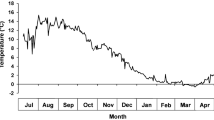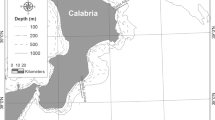Abstract
We studied the influences of food type, food quantity, water currents, starvation and light on growth and reproduction of the sea hareaplysia oculifera (Adams and Reeve, 1850) under laboratory conditions. Out of five species of algae served as food,Enteromorpha intestinalis promoted the fastest growth ofA. oculifera, Ulva spp. slower growth,Cladophora sp. allowed maintenance spp. slower growth,Cladophora sp. allowed maintenance of steady body mass, and the brown algaeColpomenia sp. andPadina pavonia were rejected by the sea hares. When sea hares were exposed to four levels of water currents, growth rates decreased as water currents increased. Sea hares fed on 50% ration grew slower than those fed on 100% ration (ad libitum). During 10 days of starvation sea hares lost weight, but when subsequently fed 100% ration they recovered and grew at a rate similar to those fed continuously with 100% ration. Under shade and under natural sunlight sea hares grew at the same rates. Whenever growth rates decreased, sea hares began to spawn at a smaller body size.A. oculifera demonstrated physiological plasticity that adapted them to varied and unpredictable environmental conditions. At different conditions of food availability they applied different tactics of resource allocation between growth and reproduction.
Similar content being viewed by others
Abbreviations
- BLM :
-
body live mass
- DM :
-
dry mass
- Ps :
-
somatic production
- Pr :
-
reproduction
- SW :
-
sea water
References
Audesirk TE (1979) A field study of growth and reproduction inAplysia californica. Biol Bull 157: 407–421
Bayne BL, Newell RC (1983) Physiological energetics of marine molluscs. In: Wilbur KM (ed) The Mollusca, vol. 4. Physiology part I, Academic Press, London pp 407–515
Branch GM (1981) The biology of limpets: physical factors, energy flow, and ecological interactions. Oceanogr Mar Biol Annu Rev 19: 235–280
Carefoot TH (1967a) Growth and nutrition ofAplysia punctata feeding on a variety of marine algae. J Mar Biol Assoc UK 47: 565–589
Carefoot TH (1967b) Growth and nutrition of three species of opisthobranch molluscs. Comp Biochem Physiol 21: 627–652
Carefoot TH (1967c) studies on a sublittoral population ofAplysia punctata. J Mar Biol Assoc UK 47: 335–350
Carefoot TH (1970) A comparison of absorption and utilization of food energy in two species of tropicalAplysia. J Exp Mar Biol Ecol 5: 47–62
Carefoot TH (1985) Energy transformation by sea hare (Aplysia) in areas of coral rubble. Proc 5th Int Coral Reef Congr, Tahiti 4: 9–16
Carefoot TH (1987)Aplysia: its biology and ecology. Oceanogr Mar Biol Annu Rev 25: 167–284
Carefoot TH (1989) A comparison of time/energy budgeting in two species of tropical sea haresAplysia. J Exp Mar Biol Ecol 131: 267–282
Carefoot TH, Taylor BE (1988) Sea hare in coral rubble: the significance of nocturnal grazing. Proc 6th Coral Reef Symp, Aust 2: 7–13
Denny MW (1980a) Locomotion: the cost of gastropod crawling. Science 208: 1288–1290
Denny MW (1980b) the role of gastropod pedal mucus in locomotion. Nature 285: 160–161
Gev S, Achituv Y, Susswein AJ (1984) Seasonal determinants of the life cycle in two species ofAplysia found in shallow water along the Mediterranean coast of Israel. J Exp Mar Biol Ecol 74: 67–83
Levin DA (1976) The chemical defenses of plants to pathogens and herbivores. Annu Rev Ecol Syst 7: 121–59
Pennings PC (1990) Predator-prey interactions in opisthobranch gastropods: effects of prey body size and habitat complexity. Mar Ecol Prog Ser 62: 95–101
Pennings PC (1991) Spatial and temporal variation in recruitment ofAplysia californica Cooper: patterns, mechanisms and consequences. J Exp Mar Biol Ecol 146: 253–274
Peretz B, Adkins L (1982) An index of age when birthdate is unknown inAplysia californica: shell size and growth in long term mariculture animals. Biol Bull 162: 333–344
Pinsker HM, Parsons DW (1985) Temperature dependence of egg laying inAplysia brasiliana andA. californica. J Comp Physiol B156: 21–27
Plaut I (1993a) Sexual maturity, reproductive season and fecundity of the spiny lobsterPanulirus penicillatus from the Gulf of Eilat (Aqaba), Red Sea. Aust J Mar Freshwater Res 44: 527–535
Plaut I (1993b) Ecology and ecophysiology of the sea hareAplysia oculifera (Adams and Reeve, 1850) in the Gulf of Eilat (Aqaba) (in Hebrew with English summary) Ph.D. Thesis, The Hebrew University, Jerusalem, 146p
Plaut I, Borut A, Spira ME (1995) Growth and metamorphosis ofAplysia oculifera larvae in laboratory culture. Mar Biol 122: 425–430
Plaut I, Borut A, Spira ME (1996) Lifetime energy budget in the sea hareAplysia oculifera. Comp Biochem Physiol A113: 205–212
Plaut I, Fishelson L (1991) Population structure and growth in captivity of the spiny lobsterPanulirus penicillatus from Dahab, Gulf of Aqaba, Red Sea. Mar Biol 111: 467–472
Sarver DJ (1978) The ecology and energetics ofAplysia juliana (Quoy and Qaimard, 1832). Ph.D. Thesis, University of Hawaii, 140 pp
Smith ST, Carefoot TH (1967) Induced maturation of gonads inAplysia punctata Cuvier. Nature 215: 652–653
Susswein AJ, Gev S, Feldman E, Markovich S (1983) Activity patterns and time budgeting ofAplysia fasciata under field and laboratory conditons. Behav Neural Biol 39: 203–220
Susswein AJ, Gev S, Achituv Y, Markovich S (1984) Behavioral patterns ofAplysia fasciata along the Mediterranean coast of Israel. Behav Neural Biol 41: 7–22
Susswein AJ, Achituv Y, Markovich S (1987)Aplysia from shallow waters along the coasts of Israel. Cah Biol Mar 28: 97–110
Switzer-Dunlap M, Hadfield MG (1979) Reproductive patterns of Hawaiian aplysiid gastropods. In: Stancyk SE (ed) Reproductive ecology of marine invertebrates. Belle W. Baruch Library in Marine Science, no. 9. University of South Carolina Press, Natl Academy Press, Columbia, S.C., pp 199–210
Willan RC (1979) The ecology of two New Zealand opisthobranch molluscs. Ph.D. Thesis, University of Auckland, Auckland, New Zealand, 198 pp
Author information
Authors and Affiliations
Corresponding author
Additional information
Communicated by H. Huddart
Rights and permissions
About this article
Cite this article
Plaut, I., Borut, A. & Spira, M.E. Effects of various environmental conditions on growth and reproduction of the sea hareAplysia oculifera (Adams and Reeve, 1850). J Comp Physiol B 166, 510–516 (1996). https://doi.org/10.1007/BF02338294
Accepted:
Issue Date:
DOI: https://doi.org/10.1007/BF02338294




